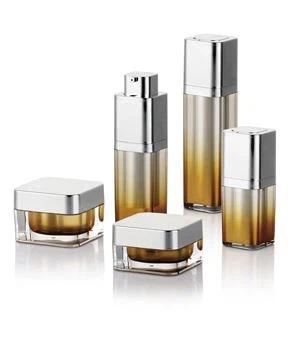Les flacons de produits cosmétiques sont généralement fabriqués à partir d'une variété de matériaux, en fonction du produit spécifique et de ses exigences en matière d'emballage. Parmi les matériaux couramment utilisés pour les flacons de produits cosmétiques, on peut citer
Plastique: Le plastique est l'un des matériaux les plus courants pour les flacons de produits cosmétiques. Différents types de plastique sont utilisés, tels que le PET (polyéthylène téréphtalate), le PEHD (polyéthylène haute densité) et le PP (polypropylène). Les bouteilles en plastique sont légères, économiques et se présentent sous différentes formes et tailles. Ils conviennent à une large gamme de produits cosmétiques, notamment les shampooings, les lotions et les crèmes.
Verre: Les flacons en verre sont souvent utilisés pour les produits cosmétiques haut de gamme ou de luxe en raison de leur attrait esthétique et du fait qu'ils sont plus résistants aux réactions chimiques avec le produit qu'ils contiennent. Ils sont couramment utilisés pour les parfums, les sérums et les produits de soin haut de gamme.
Aluminium: Les bouteilles en aluminium sont légères et offrent une excellente protection contre les rayons UV et l'oxydation. Ils sont souvent utilisés pour les produits sensibles à la lumière et à l'air, tels que certains types de crèmes solaires et d'antisudorifiques.
Acrylique: L'acrylique est un matériau transparent et durable souvent utilisé pour l'emballage de produits cosmétiques haut de gamme, en particulier lorsqu'un contenant transparent ou translucide est souhaité. Il est couramment utilisé pour emballer les vernis à ongles, les crèmes et les sérums.
Polyéthylène (PE): Le polyéthylène basse densité est un plastique souple et compressible couramment utilisé pour l'emballage de produits tels que les shampooings, les après-shampooings et les gels douche. C'est un bon choix lorsqu'il s'agit de distribuer facilement des produits.
Polypropylène (PP): Le polypropylène est un plastique durable et résistant à la chaleur qui est utilisé pour une large gamme de produits cosmétiques, y compris les baumes à lèvres, les rouges à lèvres et les crèmes.
Matériaux biodégradables: Face aux préoccupations environnementales croissantes, certaines entreprises cosmétiques utilisent des matériaux biodégradables ou respectueux de l'environnement pour leurs flacons. Ces matériaux peuvent être des bioplastiques, des plastiques recyclés ou des contenants en verre conçus pour être recyclables ou biodégradables.
Le choix du matériau dépend de facteurs tels que le type de produit cosmétique, sa durée de conservation, l'esthétique souhaitée, les considérations de coût et les objectifs de durabilité. Il est important pour les entreprises cosmétiques de choisir des matériaux compatibles avec les ingrédients du produit et les exigences de l'emballage, tout en tenant compte de l'impact environnemental des matériaux d'emballage.






